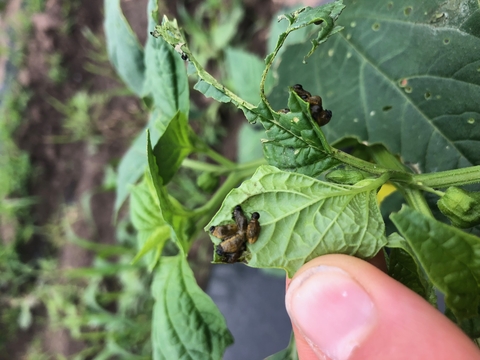Quick facts
- This beetle feeds on tomatillos, eggplants, potatoes and other plants in the nightshade family.
- It is active from May through August.
- It is usually found in low numbers and is not considered a pest, except in tomatillos, where it can be abundant and cause significant defoliation.
How to tell three-lined potato beetle from other insects
- The three-lined potato beetle is a little larger than 1/4 inch long.
- It has cream-colored to reddish-yellow wing covers with three black stripes running down its back.
- It has a reddish-orange prothorax (the area behind the head) with two small black dots on it.
- Three-lined potato beetle can be confused with a striped cucumber beetle but these two insects feed on different plants.
- Larvae are small with green bodies and shiny black heads.
- Eggs are elongated and orange.
Biology of three-lined potato beetles
- It is unclear if three-lined potato beetles spend the winter as adults or pupae. We suspect they overwinter in the soil.
- Adults appear in the spring and feed on leaves.
- Female beetles lay eggs in clusters on the underside of leaves.
- Once larvae hatch, they also feed on leaves.
- The larvae protect themselves by cementing their feces on their backs.
- Larvae transform into pupae in mid to late summer, with most adults emerging in August.
- It is unclear whether this insect has one or two generations per year.
Damage caused by three-lined potato beetles
- Adults and larvae feed on the leaves of plants in the nightshade family (tomatillos, potatoes, tomatoes, etc.).
- While adults are often seen feeding in large groups, they rarely cause major damage.
- Larvae can cause significant damage to tomatillos.
Managing three-lined potato beetles in home gardens
Three-lined potato beetles are usually not a problem, even if you see large numbers in certain areas. The first question to ask is do you need to take action at all.
- Handpick beetles and larvae and throw them into a pail of soapy water.
- Squish eggs and larvae.
- Row covers can prevent beetles from feeding on plants as long the planting is rotated as far away as possible from where nightshades were planted the previous year and the row cover is placed before you see beetles feeding.
Managing three-lined potato beetles on farms
Three-lined potato beetle is most likely to cause economic damage to tomatillos.
Cultural controls
- Removing weeds in the nightshade family, especially ground cherry, may help reduce numbers.
- Rotate your crops to make it harder for beetles to find food in the spring.
Physical controls
- Beetles can be excluded with row covers as long as crops are rotated and the cover is placed before beetles arrive.
- For small plantings, handpicking can take care of any issues.
Chemical controls
- Three-lined potato beetle isn’t on many pesticide labels, though they are related to Colorado potato beetle.
- Read the label carefully to make sure the crop and setting you want to apply to is in the label.
CAUTION: Mention of a pesticide or use of a pesticide label is for educational purposes only. Always follow the pesticide label directions attached to the pesticide container you are using. Be sure that the plant you wish to treat is listed on the label of the pesticide you intend to use. And observe the number of days between pesticide application and when you can harvest your crop. Remember, the label is the law.
Reviewed in 2024




